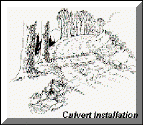
FOREST MANAGEMENT
GUIDELINES FOR MICHIGAN
By the Michigan Society of American Foresters
ROAD CONSTRUCTION and MAINTENANCE
Properly planned, constructed, and maintained roads are an asset to forest properties for most uses. Access is necessary for harvest, regeneration, protection, other management activities, and recreational uses. Excluding access is also appropriate for such objectives as protecting sensitive areas or for maintaining semi-primitive and wilderness areas. Roads have the most potential for impact.
Access roads should be carefully laid out before construction. Objectives of forest land ownership, frequency of access needs, types of vehicles to be used, relative ease of road building under existing conditions of soil/terrain and economics should all be considered when planning a permanent road system. Roads over wet soils should be limited to the shortest length possible, re-routed to upland areas, or developed for use only when frozen. Professional assistance is desirable since improper location, design, and construction of roads is probably the greatest source of soil erosion on forest lands.
Stream crossings require bridges
or culverts of a size sufficient to handle stream flow during the spring thaw
and normal floods. Stream crossing permits are required under Public Act 451,
Part 301. Contact your local Department of Environmental Quality district representative
and obtain a permit as part of the planning process whenever a stream must be
crossed. Roadside slopes and ditches must be carefully located and designed
in order to prevent stream siltation. Specifications for the bridge or culvert,
ditches, and roadsides are normally included in the stream crossing permit.
Roads should be adequately designed to accommodate the type of use they will receive. Main access routes and haul roads should be ditched and sloped to provide for adequate drainage. They should be graveled under most conditions. Secondary and temporary roads can be narrower and seeded to herbaceous cover after use in order to prevent erosion and to provide food for wildlife.
Water quality Best Management Practices (BMPs) should be applied to all road construction projects. The Department of Natural Resources Water Quality Management Practices on Forest Land manual should be used as a guide for road design and construction and are available at local Department of Natural Resources offices.
Road maintenance is important in order to minimize erosion and the expense of reconstruction. A well designed and well maintained road system will serve optimal forest use at minimal cost with minimal environmental damage. Other points to consider are do as much road work in advance to allow roadbeds time to settle and avoid use of roads when soils are wet.

This website is maintained by Bill Cook, Michigan State University Extension
Forest in the Upper Peninsula. Comments, questions,
and suggestions are gratefully accepted.
Last update of this page was 8 May, 2008
This site is hosted by School of Forest Resources and Environmental Science at Michigan Technological University.